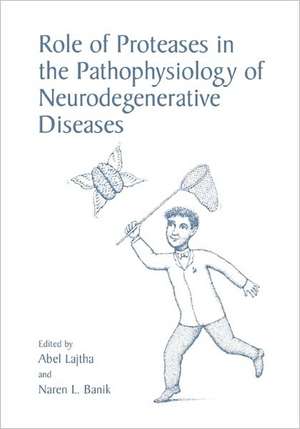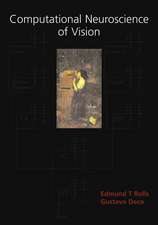Role of Proteases in the Pathophysiology of Neurodegenerative Diseases
Editat de Abel Lajtha, Naren L. Baniken Limba Engleză Paperback – 30 noi 2010
| Toate formatele și edițiile | Preț | Express |
|---|---|---|
| Paperback (1) | 949.23 lei 6-8 săpt. | |
| Springer Us – 30 noi 2010 | 949.23 lei 6-8 săpt. | |
| Hardback (1) | 956.99 lei 6-8 săpt. | |
| Springer Us – 30 iul 2001 | 956.99 lei 6-8 săpt. |
Preț: 949.23 lei
Preț vechi: 1157.60 lei
-18% Nou
Puncte Express: 1424
Preț estimativ în valută:
181.64€ • 194.23$ • 151.44£
181.64€ • 194.23$ • 151.44£
Carte tipărită la comandă
Livrare economică 17 aprilie-01 mai
Preluare comenzi: 021 569.72.76
Specificații
ISBN-13: 9781441933607
ISBN-10: 1441933603
Pagini: 320
Ilustrații: XIV, 302 p.
Dimensiuni: 178 x 254 x 17 mm
Greutate: 0.55 kg
Ediția:2001
Editura: Springer Us
Colecția Springer
Locul publicării:New York, NY, United States
ISBN-10: 1441933603
Pagini: 320
Ilustrații: XIV, 302 p.
Dimensiuni: 178 x 254 x 17 mm
Greutate: 0.55 kg
Ediția:2001
Editura: Springer Us
Colecția Springer
Locul publicării:New York, NY, United States
Public țintă
ResearchDescriere
Researchers seeking problems that offer more hope of success often avoid subjects that seem to be difficult to approach experimentally, or subjects for which experimental results are difficult to interpret. The breakdown part of protein turnover in vivo, particularly in nervous tissue, was such a subject in the past – it was difficult to measure and difficult to explore the mechanisms involved. For factors that influence protein metabolism, it was thought that protein content, function, and distribution are controlled only by the synthetic mechanisms that can supply the needed specificity and response to stimuli. The role of breakdown was thought to be only a general metabolic digestion, elimination of excess polypeptides. We now know that the role of breakdown is much more complex: it has multiple functions, it is coupled to turnover, and it can affect protein composition, function, and synthesis. In addition to eliminating abnormal proteins, breakdown has many modulatory functions: it serves to activate and inactivate enzymes, modulate membrane function, alter receptor channel properties, affect transcription and cell cycle, form active peptides, and much more. The hydrolysis of peptide bonds often involves multiple steps, many enzymes, and cycles (such as ubiquination), and often requires the activity of enzyme complexes. Their activation, modification, and inactivation can thus play an important role in biological functions, with numerous families of proteases participating. The specific role of each remains to be elucidated.
Cuprins
1. The Role of Proteolytic Enzymes in Autoimmune Demyelinating Diseases: An Update; M.E. Smith. 2. Proteases in Demyelination; M.L. Cuzner. 3. Calcium Activated Neutral Proteinase in Demyelinating Diseases; D.C. Shields, N.L. Banik. 4. Papain-Like Cysteine Proteases and Their Implications in Neurodegenerative Diseases; D. Bröme, S. Petanceska. 5. The Role of the Calpain System in Neuromuscular Disease; D.E. Goll, et al. 6. The Role of Calpain Proteolysis in Cerebral Ischemia; D.F. Emerich, R.T. Bartus. 7. Calpain Isoforms in the Eye; T.R. Shearer, et al. 8. Metalloendopeptidase EC 3.4.24.15 in Neurodegeneration; C.R. Abraham, F. Slot. 9. Cysteine Proteases, Synaptic Degeneration and Neurodegenerative Disorders; M.P. Mattson, S.L. Chan. 10. The Ubiquitin/Proteasome Pathway in Neurological Disorders; M.E. Figueiredo-Pereira, P. Rockwell. 11. Amyloid (Tace, Bace) and Presenilin Proteases Associated with Alzheimer's Disease; N. Marks, M.J. Berg. 12. Caspases in Neurodegeneration; J. Schulz, M. Moskowitz. 13. Therapeutic Approaches with Protease Inhibitors in Neurodegenerative and Neurological Diseases; K.K.W. Wang. 14. Pathophysiology of Central Nervous System Trauma: Proteolytic Mechanisms and the Related Therapeutic Approaches; S.K. Ray, et al. 15. Lysosomal Cysteine Proteases and Their Protein Inhibitors; V. Turk, et al. 16. Proteases and Their Inhibitors in Gliomas; P.A. Forsyth, et al. 17. Proteolysis of Mutant Gene Products are Key Mechanisms inNeurodegenerative Diseases; V.Y.H. Hook. 18. Mammalian Proteinase Genes; H.-J. Lee, et al.
Notă biografică
Dr. Lajtha is the editor of the Journal of Neurochemical Research.


















